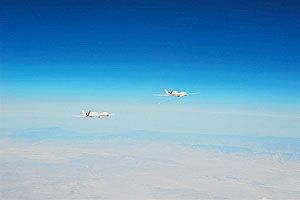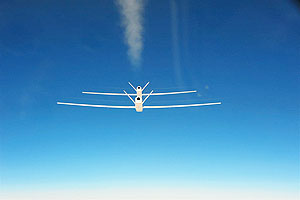
Two Global Hawk Unmanned Aircraft fly in close formation,
photo courtesy of Northrop Grumman
...completed a series of flight demonstrations, moving DARPA's Autonomous High-Altitude Refueling (AHR) program closer to demonstrating the first autonomous aerial refueling between two unmanned, high-altitude aircraft. The flights, which used two NASA Global Hawk unmanned aircraft—one configured as a tanker and the other as a receiver—were conducted at Edwards Air Force Base, California. During the flights, which spanned Jan. 11 to May 30, the AHR team achieved many milestones, including:
- The lead receiver aircraft extended and retracted its aerial refueling hose several times, completing all planned tests to validate the associated program hardware and software
- The trail tanker aircraft successfully demonstrated precision control in formation with manual and automated "breakaway" maneuvers—important safety features and criteria of the test program
- Two Global Hawk unmanned aircraft successfully flew for the first time in close formation—as close as 30 feet
- During the close-formation flight, the aircraft rendezvoused and flew for more than 2.5 hours under autonomous formation control, with the majority of the time within 100 ft (or one wingspan) of each other

Another view of two UAVs flying autonomously and in close formation,
courtesy of Northrop Grumman
As part of the U.S. Navy's Unmanned Combat Air System Carrier Demonstration program, Northrop Grumman is also developing AAR technology to help extend the operating range and flight duration of future carrier-based unmanned systems. The company plans to conduct AAR demonstrations in 2014 using the Navy's X-47B unmanned demonstrator aircraft. In partnership with NASA in the Space Act Agreement, Northrop Grumman supports the operations and maintenance of the two Global Hawks used in the AHR program and is responsible for all engineering design, as well as modification of both aircraft.

